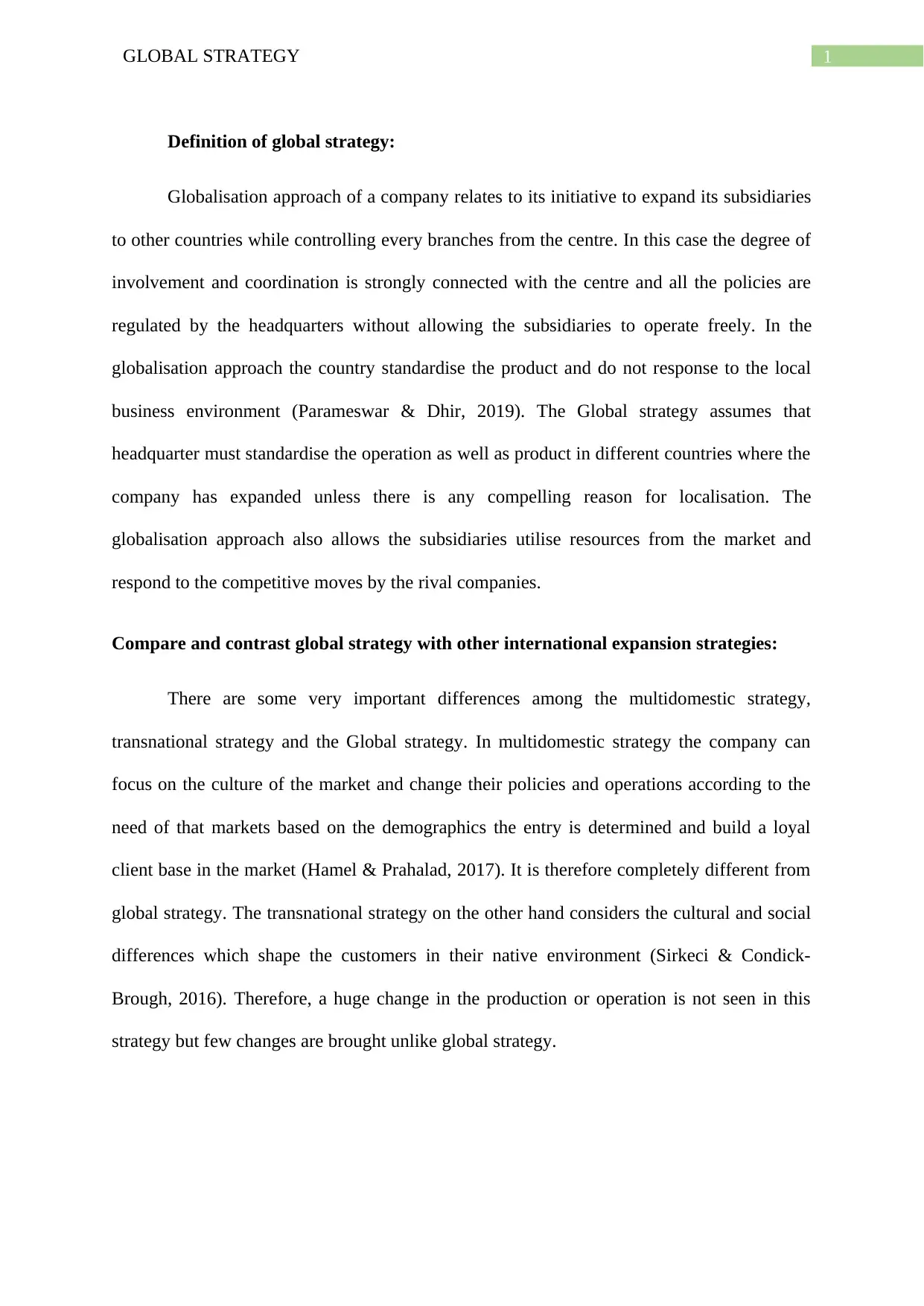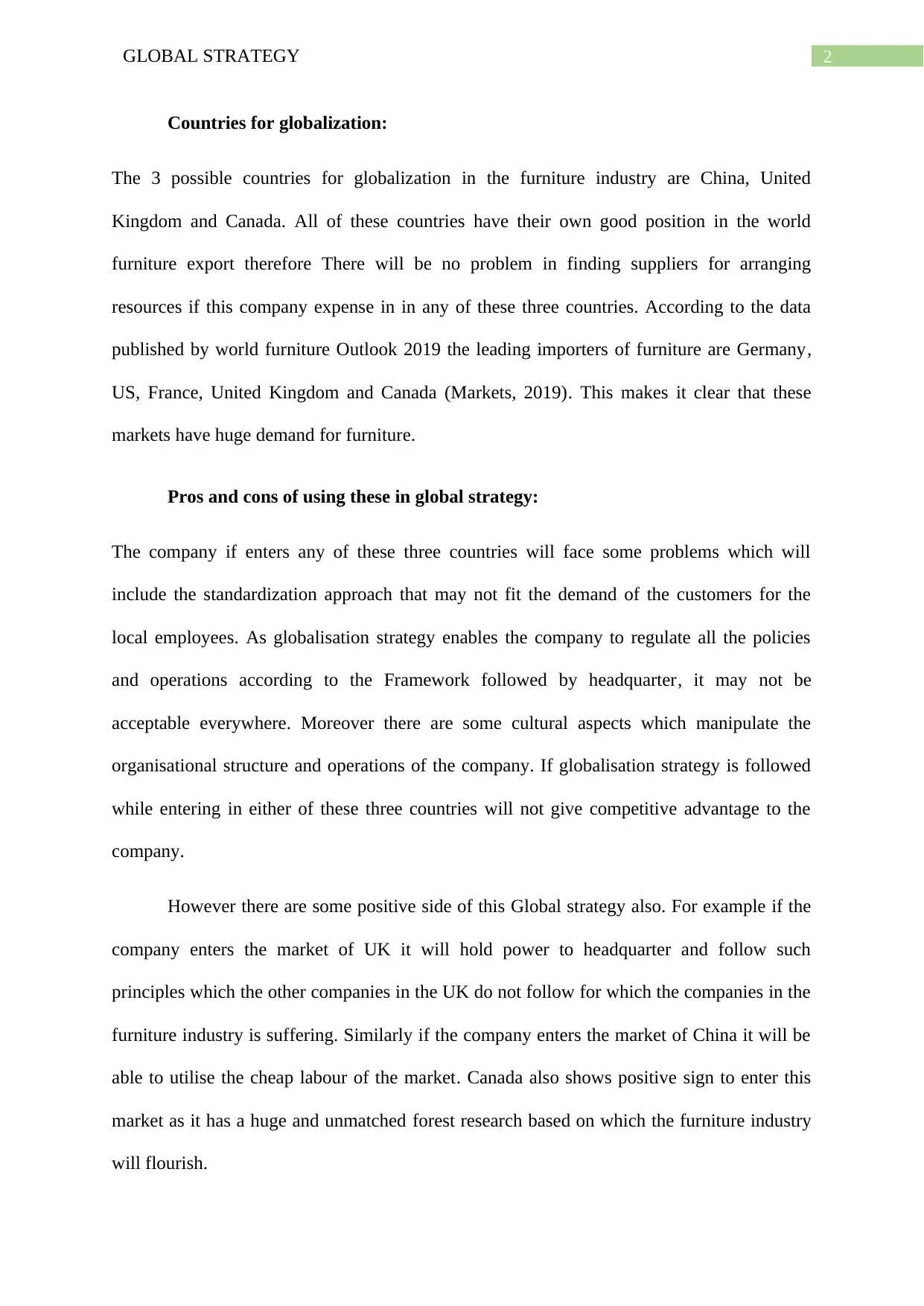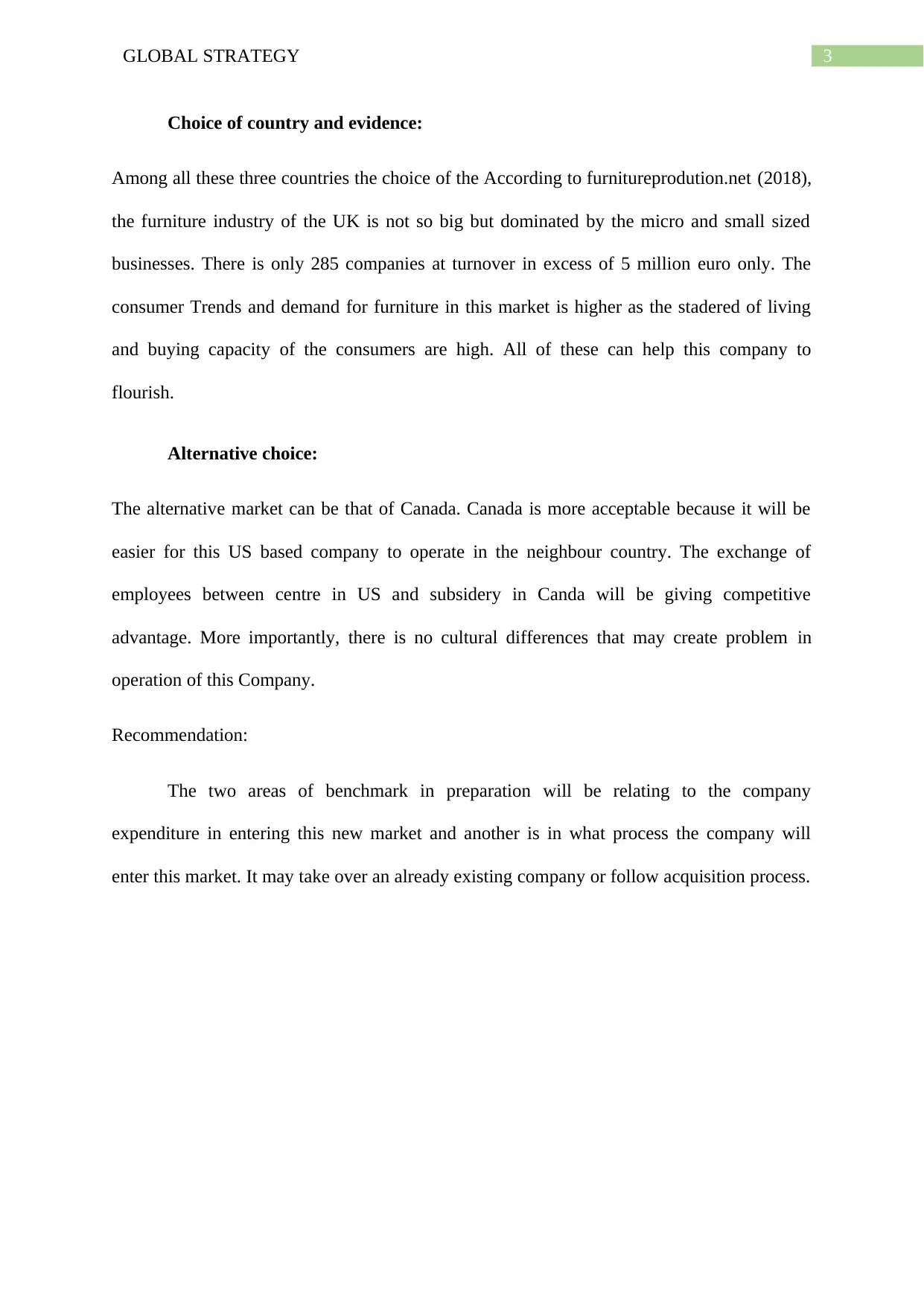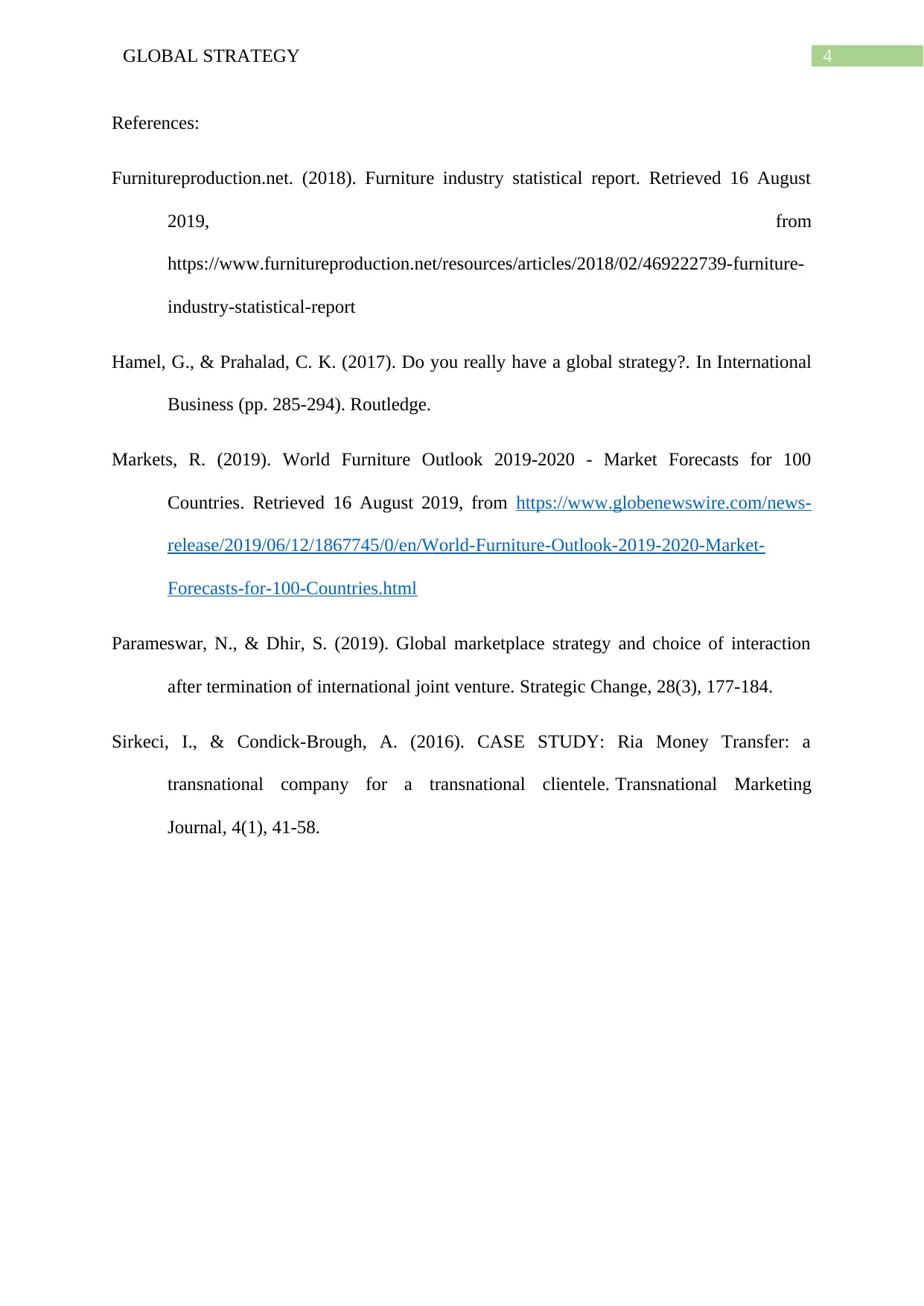Global Strategy Report: Comparing International Expansion Strategies
VerifiedAdded on 2022/09/26
|5
|993
|19
Report
AI Summary
This report provides an in-depth analysis of global strategy, focusing on its application within the furniture industry. It begins by defining global strategy as an approach where a company expands its subsidiaries internationally while maintaining centralized control and standardization. The report then compares and contrasts global strategy with multidomestic and transnational strategies, highlighting the unique characteristics of each. The core of the report evaluates three potential countries for globalization in the furniture industry: China, the United Kingdom, and Canada, considering their respective strengths and weaknesses. The report discusses the pros and cons of adopting a global strategy in each country, considering factors like standardization challenges, cultural differences, and market opportunities. The author recommends the UK market due to its consumer demand. The report concludes with recommendations regarding market entry strategies, such as acquisition or organic growth and provides relevant references.

Running head: GLOBAL STRATEGY
GLOBAL STRATEGY
Name of the Student:
Name of the University:
Author Note:
GLOBAL STRATEGY
Name of the Student:
Name of the University:
Author Note:
Paraphrase This Document
Need a fresh take? Get an instant paraphrase of this document with our AI Paraphraser

1GLOBAL STRATEGY
Definition of global strategy:
Globalisation approach of a company relates to its initiative to expand its subsidiaries
to other countries while controlling every branches from the centre. In this case the degree of
involvement and coordination is strongly connected with the centre and all the policies are
regulated by the headquarters without allowing the subsidiaries to operate freely. In the
globalisation approach the country standardise the product and do not response to the local
business environment (Parameswar & Dhir, 2019). The Global strategy assumes that
headquarter must standardise the operation as well as product in different countries where the
company has expanded unless there is any compelling reason for localisation. The
globalisation approach also allows the subsidiaries utilise resources from the market and
respond to the competitive moves by the rival companies.
Compare and contrast global strategy with other international expansion strategies:
There are some very important differences among the multidomestic strategy,
transnational strategy and the Global strategy. In multidomestic strategy the company can
focus on the culture of the market and change their policies and operations according to the
need of that markets based on the demographics the entry is determined and build a loyal
client base in the market (Hamel & Prahalad, 2017). It is therefore completely different from
global strategy. The transnational strategy on the other hand considers the cultural and social
differences which shape the customers in their native environment (Sirkeci & Condick-
Brough, 2016). Therefore, a huge change in the production or operation is not seen in this
strategy but few changes are brought unlike global strategy.
Definition of global strategy:
Globalisation approach of a company relates to its initiative to expand its subsidiaries
to other countries while controlling every branches from the centre. In this case the degree of
involvement and coordination is strongly connected with the centre and all the policies are
regulated by the headquarters without allowing the subsidiaries to operate freely. In the
globalisation approach the country standardise the product and do not response to the local
business environment (Parameswar & Dhir, 2019). The Global strategy assumes that
headquarter must standardise the operation as well as product in different countries where the
company has expanded unless there is any compelling reason for localisation. The
globalisation approach also allows the subsidiaries utilise resources from the market and
respond to the competitive moves by the rival companies.
Compare and contrast global strategy with other international expansion strategies:
There are some very important differences among the multidomestic strategy,
transnational strategy and the Global strategy. In multidomestic strategy the company can
focus on the culture of the market and change their policies and operations according to the
need of that markets based on the demographics the entry is determined and build a loyal
client base in the market (Hamel & Prahalad, 2017). It is therefore completely different from
global strategy. The transnational strategy on the other hand considers the cultural and social
differences which shape the customers in their native environment (Sirkeci & Condick-
Brough, 2016). Therefore, a huge change in the production or operation is not seen in this
strategy but few changes are brought unlike global strategy.

2GLOBAL STRATEGY
Countries for globalization:
The 3 possible countries for globalization in the furniture industry are China, United
Kingdom and Canada. All of these countries have their own good position in the world
furniture export therefore There will be no problem in finding suppliers for arranging
resources if this company expense in in any of these three countries. According to the data
published by world furniture Outlook 2019 the leading importers of furniture are Germany,
US, France, United Kingdom and Canada (Markets, 2019). This makes it clear that these
markets have huge demand for furniture.
Pros and cons of using these in global strategy:
The company if enters any of these three countries will face some problems which will
include the standardization approach that may not fit the demand of the customers for the
local employees. As globalisation strategy enables the company to regulate all the policies
and operations according to the Framework followed by headquarter, it may not be
acceptable everywhere. Moreover there are some cultural aspects which manipulate the
organisational structure and operations of the company. If globalisation strategy is followed
while entering in either of these three countries will not give competitive advantage to the
company.
However there are some positive side of this Global strategy also. For example if the
company enters the market of UK it will hold power to headquarter and follow such
principles which the other companies in the UK do not follow for which the companies in the
furniture industry is suffering. Similarly if the company enters the market of China it will be
able to utilise the cheap labour of the market. Canada also shows positive sign to enter this
market as it has a huge and unmatched forest research based on which the furniture industry
will flourish.
Countries for globalization:
The 3 possible countries for globalization in the furniture industry are China, United
Kingdom and Canada. All of these countries have their own good position in the world
furniture export therefore There will be no problem in finding suppliers for arranging
resources if this company expense in in any of these three countries. According to the data
published by world furniture Outlook 2019 the leading importers of furniture are Germany,
US, France, United Kingdom and Canada (Markets, 2019). This makes it clear that these
markets have huge demand for furniture.
Pros and cons of using these in global strategy:
The company if enters any of these three countries will face some problems which will
include the standardization approach that may not fit the demand of the customers for the
local employees. As globalisation strategy enables the company to regulate all the policies
and operations according to the Framework followed by headquarter, it may not be
acceptable everywhere. Moreover there are some cultural aspects which manipulate the
organisational structure and operations of the company. If globalisation strategy is followed
while entering in either of these three countries will not give competitive advantage to the
company.
However there are some positive side of this Global strategy also. For example if the
company enters the market of UK it will hold power to headquarter and follow such
principles which the other companies in the UK do not follow for which the companies in the
furniture industry is suffering. Similarly if the company enters the market of China it will be
able to utilise the cheap labour of the market. Canada also shows positive sign to enter this
market as it has a huge and unmatched forest research based on which the furniture industry
will flourish.
⊘ This is a preview!⊘
Do you want full access?
Subscribe today to unlock all pages.

Trusted by 1+ million students worldwide

3GLOBAL STRATEGY
Choice of country and evidence:
Among all these three countries the choice of the According to furnitureprodution.net (2018),
the furniture industry of the UK is not so big but dominated by the micro and small sized
businesses. There is only 285 companies at turnover in excess of 5 million euro only. The
consumer Trends and demand for furniture in this market is higher as the stadered of living
and buying capacity of the consumers are high. All of these can help this company to
flourish.
Alternative choice:
The alternative market can be that of Canada. Canada is more acceptable because it will be
easier for this US based company to operate in the neighbour country. The exchange of
employees between centre in US and subsidery in Canda will be giving competitive
advantage. More importantly, there is no cultural differences that may create problem in
operation of this Company.
Recommendation:
The two areas of benchmark in preparation will be relating to the company
expenditure in entering this new market and another is in what process the company will
enter this market. It may take over an already existing company or follow acquisition process.
Choice of country and evidence:
Among all these three countries the choice of the According to furnitureprodution.net (2018),
the furniture industry of the UK is not so big but dominated by the micro and small sized
businesses. There is only 285 companies at turnover in excess of 5 million euro only. The
consumer Trends and demand for furniture in this market is higher as the stadered of living
and buying capacity of the consumers are high. All of these can help this company to
flourish.
Alternative choice:
The alternative market can be that of Canada. Canada is more acceptable because it will be
easier for this US based company to operate in the neighbour country. The exchange of
employees between centre in US and subsidery in Canda will be giving competitive
advantage. More importantly, there is no cultural differences that may create problem in
operation of this Company.
Recommendation:
The two areas of benchmark in preparation will be relating to the company
expenditure in entering this new market and another is in what process the company will
enter this market. It may take over an already existing company or follow acquisition process.
Paraphrase This Document
Need a fresh take? Get an instant paraphrase of this document with our AI Paraphraser

4GLOBAL STRATEGY
References:
Furnitureproduction.net. (2018). Furniture industry statistical report. Retrieved 16 August
2019, from
https://www.furnitureproduction.net/resources/articles/2018/02/469222739-furniture-
industry-statistical-report
Hamel, G., & Prahalad, C. K. (2017). Do you really have a global strategy?. In International
Business (pp. 285-294). Routledge.
Markets, R. (2019). World Furniture Outlook 2019-2020 - Market Forecasts for 100
Countries. Retrieved 16 August 2019, from https://www.globenewswire.com/news-
release/2019/06/12/1867745/0/en/World-Furniture-Outlook-2019-2020-Market-
Forecasts-for-100-Countries.html
Parameswar, N., & Dhir, S. (2019). Global marketplace strategy and choice of interaction
after termination of international joint venture. Strategic Change, 28(3), 177-184.
Sirkeci, I., & Condick-Brough, A. (2016). CASE STUDY: Ria Money Transfer: a
transnational company for a transnational clientele. Transnational Marketing
Journal, 4(1), 41-58.
References:
Furnitureproduction.net. (2018). Furniture industry statistical report. Retrieved 16 August
2019, from
https://www.furnitureproduction.net/resources/articles/2018/02/469222739-furniture-
industry-statistical-report
Hamel, G., & Prahalad, C. K. (2017). Do you really have a global strategy?. In International
Business (pp. 285-294). Routledge.
Markets, R. (2019). World Furniture Outlook 2019-2020 - Market Forecasts for 100
Countries. Retrieved 16 August 2019, from https://www.globenewswire.com/news-
release/2019/06/12/1867745/0/en/World-Furniture-Outlook-2019-2020-Market-
Forecasts-for-100-Countries.html
Parameswar, N., & Dhir, S. (2019). Global marketplace strategy and choice of interaction
after termination of international joint venture. Strategic Change, 28(3), 177-184.
Sirkeci, I., & Condick-Brough, A. (2016). CASE STUDY: Ria Money Transfer: a
transnational company for a transnational clientele. Transnational Marketing
Journal, 4(1), 41-58.
1 out of 5
Related Documents
Your All-in-One AI-Powered Toolkit for Academic Success.
+13062052269
info@desklib.com
Available 24*7 on WhatsApp / Email
![[object Object]](/_next/static/media/star-bottom.7253800d.svg)
Unlock your academic potential
Copyright © 2020–2025 A2Z Services. All Rights Reserved. Developed and managed by ZUCOL.




